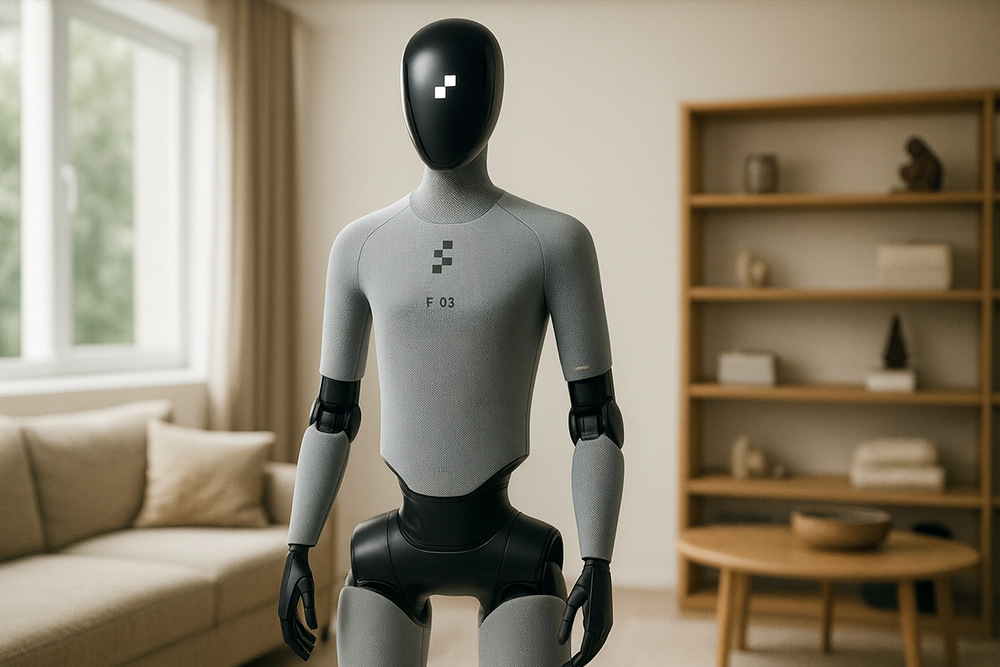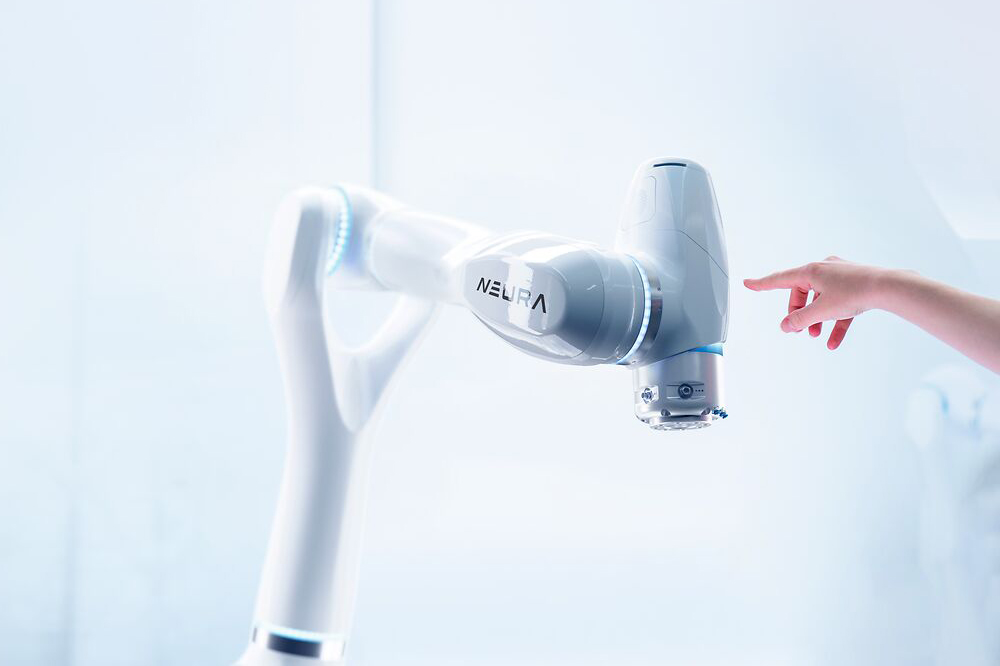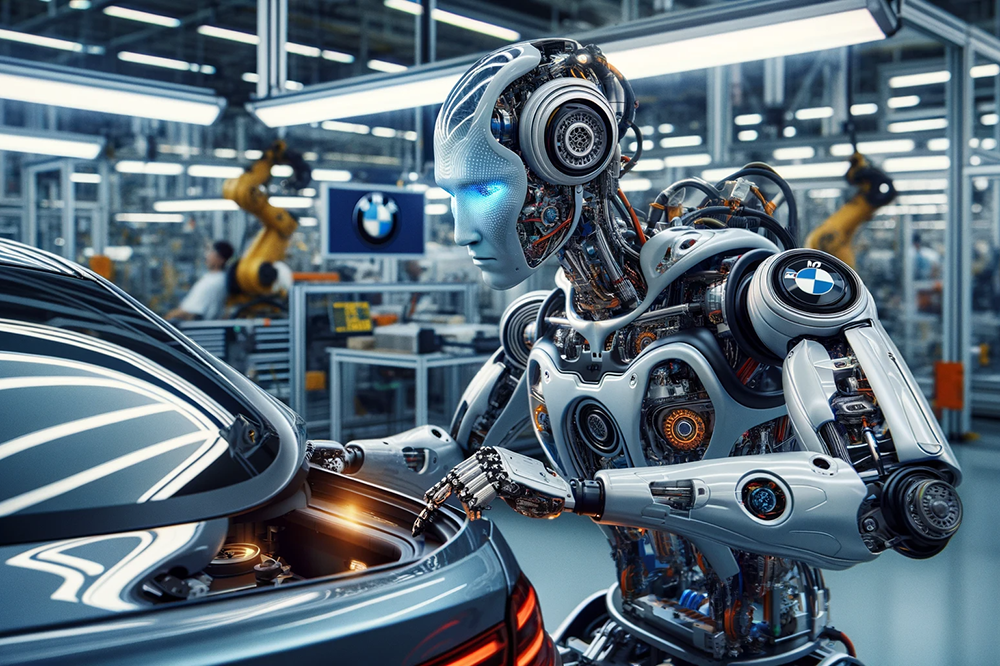On October 9, 2025, Figure unveiled its latest general-purpose robot, called Figure 03. With the help of the Helix AI platform, it can understand speech, analyze and interpret its surroundings, and take appropriate action. Figure 03 is designed for use in the home, where it can do laundry or load and unload the dishwasher. It is covered with soft textiles instead of hard, machine-finished parts. As with earlier models, the face is mask-like and unapproachable. It has integrated palm cameras and fingers with tactile sensors. The company writes: “Each fingertip sensor can detect forces as small as three grams of pressure – sensitive enough to register the weight of a paperclip resting on your finger. This precision enables Helix to distinguish between a secure grip and an impending slip before it occurs, allowing fine-grained, dexterous control over fragile, irregular, or moving objects.” (Website Figure) Hundreds of thousands of models are to be produced in the coming years. Further information is available at www.figure.ai/figure (Image: ChatGPT/4o Image).
A Delivery Robot in Zurich Oerlikon
Since August 2025, food delivery service Just Eat has been testing the use of delivery robots in Zurich Oerlikon, in collaboration with ETH spin-off Rivr. Several Swiss media outlets, including Inside IT und Tages-Anzeiger, reported on this on August 21, 2025. For two months, a four-legged robot with wheels will be delivering orders from the restaurant Zekis World. At first, a human operator will accompany each delivery run. What happens after that remains unclear. Although the robot is frequently referred to as autonomous in media reports, it’s also said to be monitored or even remotely controlled from a central hub. This setup is reminiscent of the Segway delivery robot that’s been operating in the U.S. for years, as well as Starship Technologies’ delivery robot, which Swiss Post tested near Bern in 2016. However, those models are more conventional in designe – ssentially wheeled boxes. The sleeker and more advanced Zurich robot, by contrast, travels at 15 km/h (about 9 mph), can handle obstacles like curbs and stairs, and uses an AI system for navigation. Its delivery container is insulated and leak-proof. The trial is reportedly a European first. If successful, Just Eat plans to expand the rollout to additional cities and retail applications. According to Inside IT, Rivr CEO Marko Bjelonic views the project as an important step toward autonomous deliveries in urban environments. However, some experts advise caution, especially in areas with heavy foot and vehicle traffic. Encounters with dogs and other animals must also be taken into account – initial research on this topic has been conducted in the context of animal-machine interaction.
A Cobot as Conductor of a Symphony
Cobots that dance with humans have been around for a long time. In 2016, the audience at Südpol Luzern witnessed dance and robot history being written by Huang Yi, a choreographer from Taiwan. Cobots that set the pace for humans, on the other hand, are not yet the order of the day. The Dresden Symphony Orchestra is about to perform the “Roboter.Sinfonie”. After a while, conductor Michael Helmrath will hand over to MAiRA Pro S, a product from NEURA Robotics. According to Deutschlandfunk, the machine’s three arms will be able to guide the orchestra, which is divided into groups, through the most complex passages independently of each other. This will break completely new musical ground. According to the Dresden Symphony Orchestra’s calendar, the concerts will take place on October 12 and 13, 2024 at the Europäisches Zentrum der Künste Hellerau (Image: NEURA Robotics).
Figure 01 Goes into Automotive Production
Figure, a California-based company, announced a partnership with BMW Manufacturing in a press release on January 18, 2024, to introduce general-purpose robots like Figure 01. These robots are intended to take on complex, dangerous, or monotonous tasks in automobile production to improve efficiency and safety, and allow employees to focus on more challenging tasks. The implementation will begin at the BMW plant in Spartanburg, South Carolina, after the initial phase of identifying suitable applications. This location also pioneered the use of cobots in automobile production, for example, in the insertion of door seals. Universal robots or general-purpose robots are not yet truly existing, but there are precursors to them. For instance, the Unitree H1 will be available in Germany from February. It is marketed as a general-purpose robot, although it certainly does not meet these requirements. In a similar vein is Elon Musk’s Optimus, which is not even available as a serious prototype yet. The pace-setter in this field is still Boston Dynamics with Atlas. Prof. Dr. Oliver Bendel has been extensively involved with general-purpose robots and gave a presentation on this topic at the Developer Day of the SBB on November 30, 2024 (Image: DALL-E 3).
Talk on Care Robots at Innocare 2023
Care robots can be understood as service robots and in many cases also as social robots. The talk by Prof. Dr. Oliver Bendel at Innocare 2023 on 31 August 2023 in the “Careum Auditorium” in Zurich clarified the goals, tasks, and characteristics, presented several prototypes and products and, based on this, made ethical considerations. Service robots can contribute to personal autonomy, but weaken informational autonomy. It is important to design service and social robots in the healthcare sector in such a way that they meet as many requirements and needs as possible and are useful tools for caregivers and those in need of care. Disciplines such as machine ethics can help in this regard. At the end of his presentation, Oliver Bendel discussed the morality module that has been developed in the context of this discipline. It uses a morality menu to influence the behavior of the robot using sliders. The version for care robots (CARE-MOMO) was implemented by Marc Heimann in 2022. The partners of Innocare 2023 were United Robotics Group (URG), Arabesque, Achermann und HPE Aruba Networks (Photo: Nici Jost).
Social Features for Industrial Robots
For years there has been a trend to add social features to service robots, such as delivery, security and cleaning robots, and also to industrial robots, resulting in cobots. They do not usually become fully social robots, but they benefit from having eyes and mouths or making sounds – or from being able to get very close to people without hurting or hindering them. Amazon is riding this wave with its Proteus transport robot. It can be found in a huge department store in Reading, Massachusetts. A Wired editor writes about his first encounter with two Proteus models: “Their round eyes and satisfied grins are rendered with light emitting diodes. They sport small lidar sensors like tiny hats that scan nearby objects and people in 3D. Suddenly, one of them plays a chipper little tune, its mouth starts flashing, and its eyes morph into heart shapes. This means, I am told, that the robot is happy.” (Wired, 26 June 2023) “Why would a robot be happy?”, asks the editor Sophie Li, a software engineer at Amazon. She explains that being able to express happiness can help Proteus work more effectively around people. “Proteus carries suitcase-sized plastic bins filled with packages over to trucks in a loading bay that is also staffed by humans. The robot is smart enough to distinguish people from inanimate objects and make its own decisions about how to navigate around a box or person in its path. But sometimes it needs to tell someone to move out of the way – or that it is stuck, which it does by showing different colors with its mouth. Li recently added the heart eyes to let Proteus also signal when it has completed a task as planned.” (Wired, 26 June 2023) The market for real social robots is still in its infancy. Care and therapy robots, entertainment and toy robots, or sex robots – there is a constant up and down, with companies emerging and disappearing, products appearing and disappearing. It is uncertain whether all social robots will be needed. What is certain is that social features will help to improve modern industrial robots and classic service robots.





